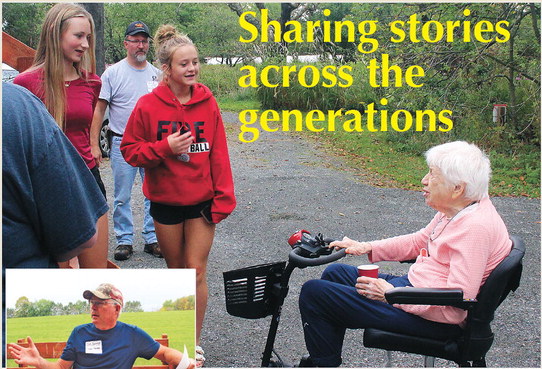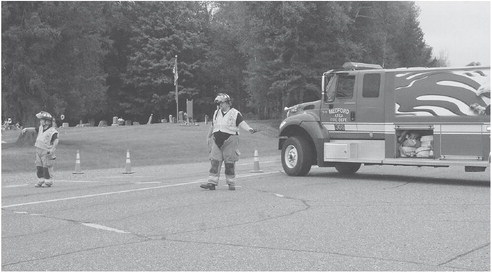County-wide EMS will be on agenda


Public Safety Committee will consider study in March
Two representatives from the South Area Fire and Emergency Response (SAFER) board last week Wednesday called on Marathon County to study whether a county-wide Emergency Medical Service (EMS) is feasible. The two board members, Keith Langenhahn and Mark Malone, said a county-wide ambulance service would improve response times, reduce costs and end duplicative efforts among the county’s EMS providers.
Langenhahn is Marathon town chairman and president of the Western Marathon County Towns and Villages Association. Malone is village of Weston president.
The pair made their pitch to the county’s Public Safety Committee. Chairman Matt Bootz, town of Texas, pledged to consider the request as an agenda item at the committee’s March meeting.
Langenhahn told supervisors that representatives of around a dozen municipalities have discussed the possibility of a county-wide EMS in informal private meetings since August. Munici- palities with representatives at the meetings have come from the town of Rib Mountain, village and town of Weston, village of Kronenwetter, town of Guenther, town of Bergen, town of Marathon, town and city of Mosinee, town of Maine and town of Bevent.
Langenhahn said the representatives were “pretty enthusiastic” about a countywide EMS in a well attended meeting held a week or two ago.
He said the need for the county service was felt most in the town of Guenther, where officials reported they were “happy” to see an ambulance show up at an emergency scene 28 minutes after being called.
Langenhahn said this lengthy response time was not acceptable. “We had a logging accident [in the town of Marathon] with a head injury,” the town chairman recounted. “SAFER was there in six minutes. That’s pretty good compared to 28 minutes.”
Langenhahn called on the county to pay for a study to determine whether a countywide EMS would be advantageous.
Malone said a county-wide EMS would end the costly, duplicative training and equipment purchase by the county’s ambulance services. He said any proposal to combine ambulance service under a single umbrella would generate “kicking and screaming” from current EMS providers, but, for the sake of “overall safety,” a county EMS needed to be pursued.
Malone said Waushara County could provide a template for a county-wide service. There, he said, the service buys ambulances in bulk and is able to save money. He said that that service is able to buy ambulances for $150,000 that current EMS providers in Marathon County pay $300,000 for. Malone said there was a training advantage of having all county EMS workers use the same equipment.
Malone said Weston would be willing to use a portion of its American Rescue Plan Act (ARPA) money to help pay for the feasibility study.
Committee chairman Bootz agreed that a 28 minute response time in the town of Guenther was not good. He said he doubted that an ambulance crew with this response time would be able to get a patient to a hospital within an hour and quickly enough to do much good.
The chairman agreed with Malone, however, that it will be politically difficult to replace the current ambulance services with a county EMS.
“It will take a soft touch to get this through,” he said.
County administrator Lance Leonhard said the state levy limits do not apply to county EMS.
This means the county board could, if it wanted to, raise county property taxes to pay for a county-wide EMS without hurting other county services.
Local response
Edgar Fire Chief Dave Wagener said he agreed that all county local fire de- partments struggle to find needed volunteers and there was duplication of costs but he did not support the county paying for a feasibility study of a county EMS.
“No, I’m not really in favor of it, not at this time,” he said.
Wagener said he didn’t know how a central EMS could improve service across western Marathon County where the various villages are located so far from each other. “We are so spread out,” he said. “You would have to have different satellite stations all over.”
Wagener said he could see the need for a county-wide service if rural departments, such as Edgar, were unable to locate sufficient volunteers. That time, however, he said, hasn’t come yet.
Marathon Fire Chief Mike Tylinski said he was not opposed to the county paying for a study. “How else are you going to find out?” he said.
Tylinski said the major challenge facing rural fire departments is getting enough volunteers.
“Everybody is struggling to find help,” he said.
Athens Fire Chief Brian Lavicka said his department was “fully staffed” with 33 firemen and 15 EMTs. He said he saw no reason for the county to pay for an EMS study.
“This is the first I’ve heard about it, but I am not for it at all,” he said. “I’m against it.”
Lavicka said he thought a county-run EMS would both cost more and lengthen response times.
“I don’t think it would be affordable,” he explained. “Response times would suffer.”
Stratford Fire Chief Tim Carey said he could possibly see a need for enhanced EMS on the eastern side of the county, but not on the west side, where local ambulance services provide good service.
“We are pretty well covered on the west side,” he said.
Carey said the Stratford EMS was functioning well and had progressed over the past three to four years. He did not support a county replacement.
“I don’t see the need for it, not in our community,” he said.
Going further, Carey said that he objected to using taxpayer money to fund a feasibility study. “It seems it would be a waste of taxpayer money,” he said.

Keith Langenhahn

Mark Malone



